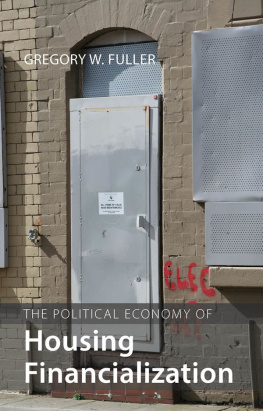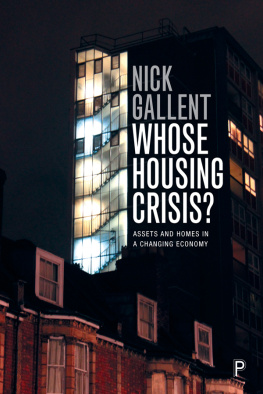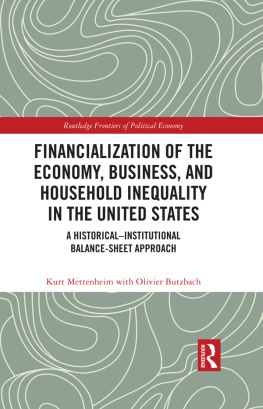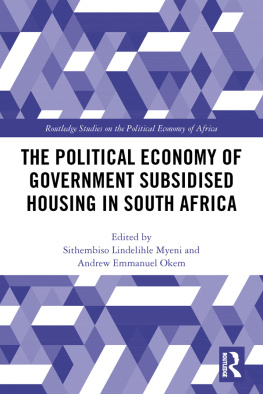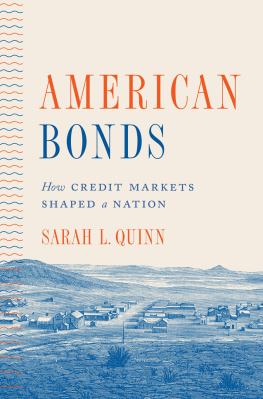The Political Economy of Housing Financialization
Comparative Political Economy
Series Editor: Erik Jones
A major new series exploring contemporary issues in comparative political economy. Pluralistic in approach, the books offer original, theoretically informed analyses of the interaction between politics and economics, and explore the implications for policy at the regional, national and supranational level.
Published
Europe and Northern Irelands Future
Mary C. Murphy
The New Politics of Trade
Alasdair R. Young
The Political Economy of Housing Financialization
Gregory W. Fuller
Populocracy
Catherine Fieschi
The Political Economy of Housing Financialization
Gregory W. Fuller
Gregory W. Fuller 2019
This book is copyright under the Berne Convention.
No reproduction without permission.
All rights reserved.
First published in 2019 by Agenda Publishing
Agenda Publishing Limited
The Core
Bath Lane
Newcastle Helix
Newcastle upon Tyne
NE4 5TF
www.agendapub.com
ISBN 978-1-78821-099-7 (hardcover)
ISBN 978-1-78821-100-0 (paperback)
British Library Cataloguing-in-Publication Data
A catalogue record for this book is available from the British Library
Typeset by Newgen Publishing UK
Printed and bound in the UK by TJ International
Contents
This book arrives at a changeable time in the political economy of developed countries. Traditional political alliances continue to fracture even as we face looming uncertainties in issues like Brexit. The challenge for a book like this is to identify political and economic relationships that cut through and perhaps partly explain the upheaval we see in the media every day. Such an effort would not have been possible without the support of a number of people.
First, I owe many thanks to the team that encouraged me to write this book, then shepherded it through the publication process. That starts with Erik Jones, series editor and mentor extraordinaire without whom I would have no academic trade to ply. It continues with the team at Agenda Publishing, particularly Alison Howson, as well as Clare Owen at Newgen Publishing.
Second, my understanding of the political economy of housing as well as financialization has been greatly enhanced by my work with a number of colleagues. Above all, this includes my frequent partners-in-crime, Alison Johnston and Aidan Regan, with whom I have published a number of articles related to the central themes of this book. More broadly, I am deeply grateful to the fantastic interdisciplinary community of Europeanists, financialization scholars, and housing market specialists dedicated to improving our understanding of how both financial markets and housing systems interact to affect our lives. Where at all possible, my thanks are offered in citation form! I also owe a debt of thanks to the anonymous reviewers of this manuscript.
Finally, I could not complete any writing project at all without the forbearance, forgiveness, support, and love of my family. This book is for Abby and Carole my sunshine and my unfailing anchor and all the sacrifices they make to keep me writing. I promise Ill take a break for a while.
Erik Jones
At some point in the early months of 2007, the words sub-prime mortgages began to filter into the popular press. By the end of that August, they were ubiquitous. This small section of the high-risk, high-yield housing finance market in the United States sparked a global financial and economic crisis that would scar a generation. The stories that emerged to explain how this happened were the stuff of fiction or perhaps something even stranger. Banks booked mortgages to people with no demonstrable assets or income, at introductory rates that quickly reset to terms that only the most resilient of households could afford. By the time the borrowers defaulted, however, the banks had sold the mortgages to other investors using complicated securitization instruments that effectively hid the risks involved. The institutions left holding the bag were not only unaware of the dangers they faced but were completely unprepared for the consequences.
The sub-prime mortgage disaster sounds improbable after the fact and caught many by surprise from start to finish. It would be easy to assume, therefore, that the whole episode could be marked down to some horrible financial accident where the most dangerous financial market participants played with the most volatile financial instruments and nearly brought the whole advanced industrial global economy down with them. Indeed, it would be comforting if that were the case. Then all we would need to do is discipline the people and regulate the instruments.
Unfortunately, the forces that created the US sub-prime mortgage problem are not accidental; they are structural. Moreover, once you understand which are the structures involved, there is little mystery to why the crisis started in the sub-prime mortgage sector, why the epicentre was located in the United States, and why the securities created out of sub-prime mortgages found their way onto the balance sheets of financial institutions across advanced industrial economies. There is also no mystery why a crisis in the US sub-prime mortgage sector would bring the global financial economy to its knees.
This structural account is what Gregory W. Fuller brings to life in his analysis. He explains why it is that banks have come to rely on households to create assets for investment as the money that can be made from intermediating savings in the non-financial corporate sector have outstripped the revenues available from real investments. The role of securitization in this account is to provide an essential lubricant, making it easier for banks to create assets out of household borrowing and then turn those into cash that can be lent again. Moreover, the story traces back to the problem of macroeconomic imbalances where savings in one country move across borders to chase foreign opportunities for investment. In the reverse of the usual pattern, what looks like a finance and microeconomic problem on the surface quickly reveals its underlying macroeconomic foundations.
Residential real estate lies at the centre of this dynamic because housing is the most valuable asset that families have to pledge when they take on debt. In turn, this means that households can enhance their leverage when borrowing which is another way of saying that banks can create larger assets at lower risk by convincing households to take on mortgage debt. Even the famous sub-prime mortgages are backed by residential real estate as collateral and so compare favourably to unsecured student loans or consumer debt.
This dynamic manifests differently from one place to the next. Countries that attract more savings from abroad are more powerfully affected by the hunt for yield in the financial sector and the pressure to convince households to take on mortgages; so are countries where the governments make it easier for banks to securitize new lending and so pass along the risks associated with the assets they create. The United States is the worlds leader in both attributes, as a haven for foreign portfolio investment as an efficient securitization market. Other countries like Denmark tend to finance their mortgage markets domestically and they also tend to force their domestic banks to hold onto the risks associated with the assets they create. The Danes have enormous household borrowing and associated housing bubbles, but their problems are not those found in the United States.
Next page
